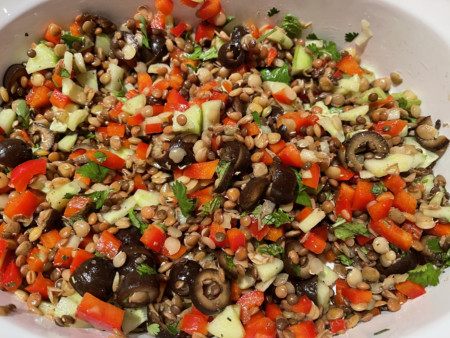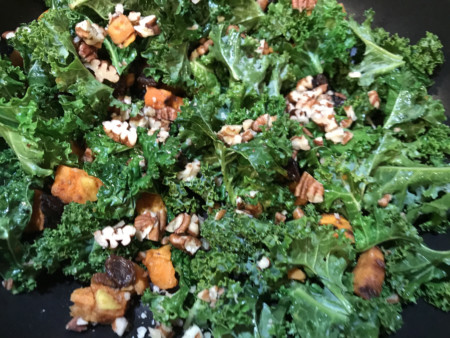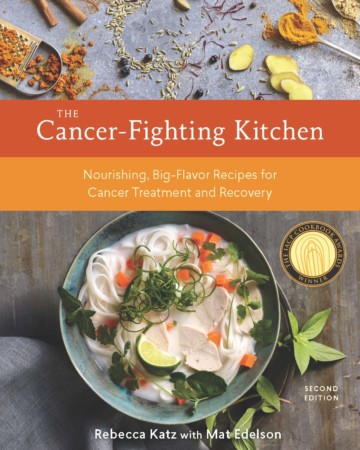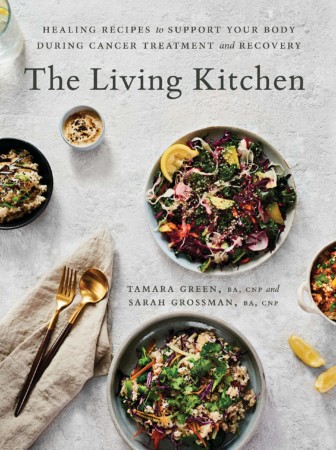Health is like money. We never have a true idea of its value until we lose it. Josh Billings.

When faced with a glioblastoma diagnosis, it is essential to keep the body as strong as possible so it can effectively recover from the standard of care protocol— brain surgery, chemo/radiation, and a second round of chemo. To accomplish this goal, I researched how diet and exercise can positively impact the ill effects of cancer treatments. Until I started implementing these changes, it was unclear whether any of these modifications would make a difference. While Ira is only one glioblastoma patient, I can say with confidence that he has responded better than I ever anticipated.
RESEARCHING AND IMPLEMENTING NEW RECIPES
Countless online articles and award-winning books promote the connection between diet and health. In a previous story, I reviewed Eat to Beat Disease and in future stories I will share what I learned from other books and online sites. Many of these books include a small selection of recipes and basic menu plans. Since I didn’t feel like I had adequate information to devise long-term menu planning, I started searching for online recipes and purchased several cookbooks.
By following these new recipes, I enhanced my cooking skills and reinforced my understanding of nutrient-dense diets. If you don’t have time to read books about the relationship between food and health, the opening chapters of most cancer cookbooks will open the door to this noteworthy connection. After absorbing these basics, I began the task of planning menus designed to lessen the ill effects of Ira’s harsh cancer treatments while simultaneously helping his immune system and increasing his appetite.
Within no time, Ira reaped the intended benefits of the diverse recipes. While it was not possible to avoid any weight loss associated with chemo and radiation, Ira’s energy levels remained intact. In 2021, we were able to downhill ski, hike, snowshoe, horseback ride, and deep-water snorkel. Other than a few short weeks during radiation when metallic and weird tastes caused Ira’s appetite to diminish, he maintained his desire to eat.
While there are many cancer cookbooks on the market, I found The Cancer-Fighting Kitchen: Nourishing, Big Flavor Recipes for Cancer Treatment and Recovery by Rebecca Katz and Mat Edelson and The Living Kitchen: Healing Recipes to Support Your Body During Cancer Treatment and Recovery by Tamara Green and Sarah Grossman to be wise investments. Months after Ira completed his last chemo treatment, I am still cooking some of Ira’s favorites as well as continuing to explore new recipes.
To help glioblastoma patients and care partners become empowered in their healing process, I will provide a brief overview of these two cookbooks.
THE CANCER-FIGHTING KITCHEN
In the Preface, four cellular processes are identified for their ability to affect cancer cells: inflammation, oxidative stress, blood sugar regulation/insulin production, and normal cell death.
When any of these processes go out of balance for a long period of time, the body’s cellular defenses fail and cancer can proliferate. The typical Western diet, which is low in plant foods (produce) and high in sugars, saturated fats, and processed foods, is known to weaken the control of all of these mechanisms. (page xi)
Once I accepted this fact, I knew that it was in Ira’s best interest to maintain a state of equilibrium by avoiding the key culprits of a typical Western diet. We likewise believed that a ketogenic diet might weaken Ira’s body due to its lack of nutrient-dense foods. While preliminary studies do indicate that the ketogenic diet may be effective in prolonging glioblastoma patients’ lives, we felt it was a more challenging diet to follow with potential long-term risks.
While an unknown percentage of glioblastoma long-tail survivors do not modify their unhealthy diets after diagnosis and live longer than the average, I cannot ignore the science that shows the benefits of eating a plant-based diet with minimal sugar and processed foods. It remains unclear why some people can make poor lifestyle choices and live into their 90s. My own mother is a perfect example. Throughout her life, she made terrible lifestyle decisions and did not suffer any medical repercussions until she her mid 80s.
Since most medical doctors do not receive adequate nutritional training, I don’t believe they can speak with much authority about how diet affects cancer cells. One of Ira’s second opinion neuro-oncologists told us that Ira’s diet would have not have an impact on his future. Naturopaths, cancer nutritionists/dietitians, herbalists, integrative medicine providers, and researchers are thus better resources.
If diet doesn’t play a role in cancer, why have the American Cancer Society, the American Institute for Cancer Research, the American Association for Cancer Research, and the Physician’s Committee for Responsible Medicine, created cancer preventing nutritional guidelines? (Page xii) As additional clinical trials and studies are completed, perhaps we will learn more about how a glioblastoma patient’s diet can impact his/her survival. In the meantime, our game plan is to take a multi-tiered approach with diet as one of the cornerstones.
Cancer-Fighting Tool Kit
Surgery, chemotherapy, and radiation can cause significant side effects.
Cancer treatments can negatively impact immunity, inflammation, blood sugar regulation, digestion, and a whole host of other bodily systems. (Page 8)
By selecting appropriate foods, the authors feel cancer patients undergoing treatment can minimize the common symptoms of fatigue, nausea, anemia, constipation, dehydration, diarrhea, mouth sores, swallowing issues, weight loss, and low immune function or low white blood cell counts.
Every week, I read articles hyping certain “magical” foods. This cookbook takes a broader approach by recognizing that each of us will process foods differently.
Science doesn’t yet have a way of figuring out each individual’s digestive ‘blueprint,’ but it’s getting there; it’s the emerging field of nutrigenomics, which eventually will allow us to determine which enzymes each individual is capable of producing, and what food they can best digest to make nutrients bioavailable. In the meantime, experts suggest that you hedge your bets during treatment by eating a wide variety of healthy foods. (Page 9)

On pages 9-12, charts show which recipes should be used for specific side effects while Pages 13-17 examine menu planning in the days just prior to chemotherapy or immunotherapy, the days between treatment, and afterwards. Like other cancer cookbooks, the authors strongly encourage using organic products and include the list of the dirty dozen and clean fifteen for an easy reference. (Page 41)
To address the issue of potential taste changes during radiation treatments, this cookbook uses a tool referred to as FASS (Fat, Acid, Salt and Sweet)
Each element of FASS represents a culinary quadrant of the dartboard. When they’re balanced and work in harmony, you’ll hit the bull’s-eye. Acid and salt add high notes to the taste, each in its own way; fat and sweet tend to bring roundness and fullness to a dish. FASS is really just an acronym to remind you of these fundamentals… (Page 18)
Since Ira did experience some taste issues, I found the FASS Fixes for Taste Bud Troubles on page 20 to be useful.
The role of spices cannot be underestimated. Knowing how to use them is another story. I appreciated these helpful tips:
When using dried herbs and spices, add them near the beginning of the process, especially if the dish is cooked. The reason? Heat, especially in combination with a bit of fat such as olive oil, breaks down the oils in the herbs and spices and releases them into the food. These oils carry much of the taste, and with the healing benefits of phytochemicals. As far as fresh herbs like cilantro, mint, and parsley are concerned, it’s best to add them at the end, to retain maximum flavor and color. (Page 24)
Further down on the page, is a chart outlining which spices are associated with Mediterranean, Middle Eastern, North African, Thai, Indian, and Mexican cuisines. For enhanced flavor, the authors recommend using at least three spices in a category.
After reading Eating to Beat Disease, I know that foods can have both positive and negative effects on the body. Thus, it is not surprising that this cookbook includes an alphabetical list of foods (Page 29-38), along with descriptions, outlining how these foods are connected to antiangiogenesis, NF-kB regulation, apoptosis, DNA repair, and anticarcinogenic properties.
Recipes
The bulk of the book showcases an abundance of tasty recipes organized in the following chapters—Nourishing Soups and Broths, Vital Vegetables, Protein-Building Foods, Anytime Foods, Tonics and Elixirs, Dollops of Yum and Sweet Bites. At the end of each recipe, variations and tips are offered along with recommendations for storage. A select number of recipes have corresponding images. The prep time for most of the recipes is short and reasonable. This cookbook has almost 50 more recipes than The Living Kitchen.
THE LIVING KITCHEN
At the beginning of chapter one, Green and Grossman help readers see the significance of good food choices.
Proper nutrition can help keep your body strong as it undergoes intense therapies to kill cancer cells, and what you eat can mitigate common side effects like nausea, loss of appetite, and fatigue. Colorful vegetables and fruits, healthy proteins, and good fats possess antitumor and antiangiogenesis, antioxidant, anti-inflammatory, and antimutagenic properties…These foods act synergistically with each other and with treatments to help speed up recovery time and make some therapies more effective. (Pages 5-6)
Green and Grossman advocate for a diverse plant-based diet devoid of processed foods. These colorful options have phytonutrients with anticancer properties. While they recognize that some other authorities are promoting ketogenic, vegetarian, or gluten-free diets, they believe that these diets have a shared emphasis on fruits and vegetables. To gain a better understanding of the material covered in the first five chapters, Green and Grossman include a few pages of end notes. Throughout the first quarter of the book, they share useful tips. Here is a sampling:
CHAPTER 2- “LET FOOD BE THY MEDICINE”
Healthy Fats
Chart of healthy fats describing the safest maximum temperature, why the oil should be used, why it may not be healthy, and when to use it. (Pages 16-17)
Carbs, Sugar, and Cancer
Refined grains and sugar are essentially empty calories. They provide the body with minimal to no nutrition, and they lead to elevated blood sugar and insulin levels that promote fat storage and inflammation, and in turn heighten cancer risk. This is why it’s ideal to eat more unrefined complex carbohydrates instead of refined ones. Insulin increases other hormones known as insulin-like growth factors. This can enhance tumor growth and is known to increase the risk of breast, prostate, colon, and lung cancers. (Page 19)
Keeping this in mind, it is easy to understand why Green and Grossman promote a diet with “high-quality carbs like whole grains, legumes, beans, and colorful vegetables.” (Page 19)
Protein
Before, during, and after treatments, the body’s need for protein will increase. If glioblastoma patients are not consuming enough protein, the body will begin to break down muscle tissue. The authors do not voice a preference for animal or plant-based proteins. The book includes both Omnivore Mains and Vegetarian Mains chapters. They highly suggest that people avoid store bought nutritional supplement drinks. Instead, they recommend making smoothies from scratch without refined sugar and artificial ingredients. (Page 21)
Antioxidants
Free radicals are unpaired electrons that create damage to your body. As they try to find another electron to pair with, they create oxidative stress tin the form of mutations to the cells. They are mainly produced by pollution, poor diet, certain cooking methods, smoking—and chemotherapy and radiation. Antioxidants help combat oxidative stress by neutralizing and pairing with free radicals, inhibiting them from creating harm and damaging cells. (Page 23)
As a result, many of their recipes include walnuts, sunflower seeds, almonds, raw cacao, goji berries, blueberries, Brussels sprouts, broccoli, kale, cauliflower, avocados, sweet potatoes, carrots, onions, garlic, and green tea.
Phytonutrients
Where do you find phytonutrients? …in fruits and vegetables.
Phytonutrients have potent anticancer properties that work in unique ways to decrease abnormal cell growth, inhibit the spread of cancer cells and formation of their new blood vessels, and promote cancer cell death. Similar to antioxidants, phytonutrients are more effective when eaten together instead of separately. (Page 23)
On the next page, a useful chart separates phytonutrients into categories and discusses their benefits. Whenever possible, I try to make sure that I include a cross-section of phytonutrients every day.
CHAPTER 3- FUNCTIONAL & DYSFUNCTIONAL FOODS
Anyone who has ever read any articles or books that hype plant-based diets will not be surprised by the pages describing functional foods. This quick overview stresses the importance of including cruciferous vegetables, mushrooms, turmeric, probiotics and fermented foods, omega-3 fatty acids, allium family vegetables, bone and vegetable broth, soy, vegetable juices, super greens, and herbs and spices, into one’s diet.
Foods to be avoided are also singled out. This list includes red meat, processed meat, unfermented dairy, refined sugar, refined grains, processed foods, artificial sweeteners, natural sweeteners in moderate or large quantities, alcohol, and vegetable oils not found on pages 16-17.
Chapter 4- Eating to Combat Common Side Effects
I found this chapter to be extremely interesting and useful. Based on the authors’ experience as holistic nutritionists who offered their services to cancer patients, they created pre-treatment, treatment day, and post-treatment menus. Additionally, there are sections describing recommended foods for the following side effects—nausea and vomiting, loss of appetite, altered taste, loss of taste, reduced ability to smell, dry mouth, sore mouth, difficulty swallowing, diarrhea, constipation, weight loss, fatigue and exhaustion, depression and anxiety, as well as what to eat when in remission.
Chapter 5- Preparing the Kitchen
Before trying the recipes, Green and Grossman offer useful suggestions on how to buy the healthiest ingredients and how to equip your kitchen with the best equipment. If you are not already aware of the dirty dozen (the most contaminated items) and the clean fifteen (least pesticide residue), I recommend looking at the chart on page 64. You will also find useful tips for purchasing nuts and seeds, beans and legumes, poultry and meat, fish and seafood, and eggs in this chapter. I agree that a quality food processor and a blender are essential.

Chapter 6- The Recipes
The recipes are arranged by meal type and conveniently include icons showing the corresponding symptom the recipe will address. Each chapter begins with its own index and colorful food images are sprinkled throughout the book. The categories include smoothies, juices and elixirs, breakfasts, soups, omnivore mains, vegetarian mains, sides, snacks, desserts, sauces, marinades, and dressings. On the left sidebar the authors often include nutritional information about one or more ingredients. At the end of the recipe they offer useful tips and suggestions for substitutions. Even though there are less than a dozen options in each category, I had no problem finding several appealing recipes to make in each section.
CONCLUDING THOUGHTS
To date, I have not tried a recipe in either cookbook that ended in a disaster. I have made many of the recipes several times. These easy-to-follow recipes introduced me to a style of cooking infused with organic fruits and vegetables and an assortment of fresh herbs and spices. Since I am aware of the impact that sugar has on cancer cells, I sometimes decrease the amount of maple syrup, honey, or coconut sugar in these recipes. Both of our A1C blood tests have been positively impacted by our healthier diets.
I also learned the importance of feeding Ira with a variety of phytonutrients that met his particular needs during treatment and thereafter. Both books offer useful tips with background information. My desire to cook meals devoid of processed foods opened the door to making soups and sauces/dressings from scratch and discarding boxes, bottles, and bags with ingredients I could not pronounce. As a result, I spend a significant amount of time in the kitchen every day preparing nutrient-dense recipes.
While our diet is only one part of our multi-tiered approach to embrace life and not cancer, Ira’s ability to maintain his pre-diagnosis quality of life is a noteworthy accomplishment.
If one or both of these cookbooks becomes an asset during your glioblastoma journey, please let me know. Feel free to share your favorite recipe in the comment section below.
Related Posts
Should Glioblastoma Patients Investigate Radical Remission?
Anyone who is looking for ways to beat the odds, should read this.
Mark Your Calendar -Glioblastoma Awareness Day – July 21, 2021
To bring attention to Glioblastoma, Sandy highlighted the ability to embrace life after a glio diagnosis.
Celebrating Wedding Anniversary in Kauai, Hawaii
To celebrate their 46th wedding anniversary and life, Sandy and Ira explored Kauai.
Spring Getaway to Captiva Island, Florida
A late spring getaway took us to romantic and picturesque Captiva Island.
Grand Hyatt Vail Healthy Cuisine
Yes, you can maintain a healthy diet while traveling.
Tackling the Back Bowls at Vail While Media Guests at the Grand Hyatt Vail
Can you believe that until spring 2021, I had never skied at Vail? Thanks to a media trip hosted by the Grand Hyatt Vail, Ira and I explored this amazing terrain. Our youngest son, Jordan, led the way to their famous back bowls.
While Ira was undergoing chemo, we went horseback ride, snowshoe, and learned archery at Vista Verde Ranch, a luxury dude ranch near Steamboat, Colorado.
New Year’s Tradition at Keystone Resort
Glioblastoma and chemo did not stop Ira from skiing more than 20 times with glioblastoma.
BIO
Sandra Bornstein is the author of May This Be the Best Year of Your Life. Sandra’s memoir highlights her living and teaching adventure in Bangalore, India. She was a licensed Colorado teacher who taught K-12 students in the United States and abroad. Sandra also taught college-level courses at Front Range Community College and the University of Colorado-Boulder.
In addition to reviewing books and interviewing authors, Sandra is an award-winning author and lifestyle and travel journalist. Many of Sandra’s travel stories appear on the For Readers Page. To follow Sandra’s travel adventures, visit TheTravelingBornsteins website.


Connect with Sandra